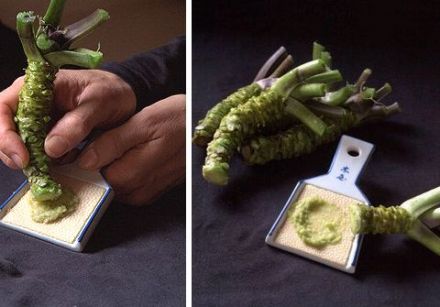 |
French: wasabi
Often compared to western horseradish, wasabi is also a root that is used as a condiment, though it is actually a different species. It is used in similar ways, though its flavor is milder.
Etymology
the word "wasabi" in Japanese means "mountain hollyhock"
Family
perennial plant of the Cruciferae family
Growing
- allow two years between planting and harvest
- the plant needs a lot of water and sunlight
- the city of Hotaka, Japan, is one of the country's principal providers of wasabi. The inhabitants devote a lot of time to weeding and eliminating insect pests.
To obtain the best flavour, texture and heat of sawa Wasabi the rhizome must be ground into a fine paste. In Japan the traditional method for grating Wasabi uses a sharkskin grater or “oroshi". If a sharkskin grater is not available, ceramic or stainless steel surfaces can be used. The important component of the grater is the teeth or nubs. Smaller teeth produce a finer paste that increases the unique heat and flavour of fresh Wasabi. Grating Wasabi releases volatile compounds, called isothiocyanates that gradually dissipate with exposure to the air. These compounds are not found in Wasabi until after the cells of the plant are broken up and turned into a paste. The finer the paste the more chemical reactions take place. Using a Wasabi grater and keeping the rhizome perpendicular to the grating surface minimizes exposure to the air. In this way, the volatile compounds are allowed to develop with minimal dissipation. This combination of natural volatiles, consistency and texture distinguish fresh wasabi from the imitation products of powdered and paste horseradish, which have been mixed with Chinese mustard and green food colouring.
How To Grate Wasabi
- Wasabi rhizome finely grated on shark skin grater.
- Rinse the rhizome under cold running water.
- Scrape off any bumps or rough areas along the sides.
- Scrub the rhizome with a stiff brush under cold running water and pat dry.
- Cut the rhizome just below the leaf base.
- Hold the rhizome perpendicularly to the surface of the grater and grate the rhizome using a circular motion. Grate only what will be used within 10 or 15 minutes as the flavour will begin to dissipate within a short period of time.
- If you are using a sharkskin grater, rinse it under cold running water and let it air dry.
In Japan, the root is grated and made into a paste to which a little soy sauce is added, but outside Japan, it's very difficult to obtain the fresh root. It is found on the market in two forms:
- powdered - simply add a few drops of water and/or soy sauce to form a paste
- paste, sold in tubes - refrigerate after opening

Wasabi is a staple condiment in Japanese cuisine and traditionally served with sushi, sashimi, soba noodles and other Japanese dishes.
The leaves can be eaten fresh as a salad green, used as a flavour in foods or pickled fresh in sake brine or soy sauce.
Today Wasabi’s unique flavour and heat is being recognized in ‘fusion’ styles of cooking.
To order fresh wasabi : www.wasabia.com

-

 Recipes
Recipes
-

 Products
Products
-

 Entertaining
Entertaining
-

 Chefs
Chefs
-

 Hints & Tips
Hints & Tips
-

 Glossaries
Glossaries








